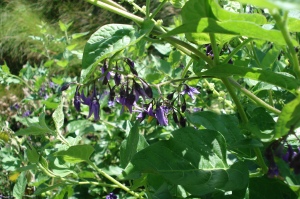As a child I was brought up to recognise, name and avoid poisonous plants, so I have long been familiar with a couple of wild members of the nightshade family: woody nightshade and deadly nightshade (AKA Belladonna).
At some point in life I picked up the fact that potatoes are related to them and that tomatoes have similar characteristics to potatoes, but it was only when I started vegetable gardening that I saw more similarities and realised that aubergines and sweet/chilli peppers are all part of the same family (scientific name: Solanaceae). Once I started investigating the nightshades I was surprised to find that tobacco is also a member of the family, as is the legendary mandrake. It’s obviously a very successful group of plants and one with a large role to play in human life (and/or death!) and I find it fascinating that a group of plants with so many poisonous characteristics have contributed so much to us.Potatoes, tomatoes and aubergines are all classified in the genus “solanum”, while the peppers are “capsicums”. We’re growing all of these this year and so I’ve had good opportunity to observe their similarities and differences. If you’ve read my previous post Bonding with plants you’ll already know that the aubergines in particular have caught my attention and you may have noticed how similar the flower is to tomato/potato/nightshade flowers. All of these plants have the same distinctive flower shape. The solanums all have hairy leaves although the aubergine’s relatively simple oval leaves are unlike the complex tomato and potato leaves. The basic growing shape of the plants is most similar between pepper and aubergine.
Belladonna and mandrake seem the most mysterious and fairy-tale of the nightshades to me, despite woody nightshade’s seductive jewel-bright toxic berries. Belladonna has been famously used as a medieval cosmetic, but also as a poison and a medicine. Mandrake has been steeped in myth and is frequently associated with witchcraft in literature, possibly because of its hallucinogenic poisons. The forked and oddly shaped root has been thought to resemble a person and it was thought to scream when pulled up (Shakespeare refers to this in Romeo and Juliet).
So are there toxins in the vegetables? Apparently there are, although opinion is divided on how worrying that is. It seems that if you have arthritis you should consider avoiding these foods (for more information see The Arthritis Nightshades Research Foundation) because of the alkaloid toxins they contain. Most people know you should avoid green potatoes and that is because the (harmless) green colour is usually accompanied by an invisible increase in alkaloids. Nicotine is one of the various alkaloid compounds present in nightshades and I was surprised to find that tobacco is not the only member of the family to contain it – all of the vegetable nightshades contain some. However, you’re unlikely to find tomatoes a good substitute for a nicotine patch as it’s only present in very small amounts in the vegetables. This page gives some figures. Cooking reduces the alkaloids present by 40-50%.
So am I concerned about nightshades in my diet? No, not at all. Living is generally quite bad for your health. Every food group that I can think of has some negative research and advice attached to it but the only thing worse for your health than eating food is eating none!


